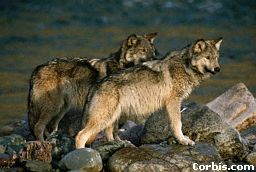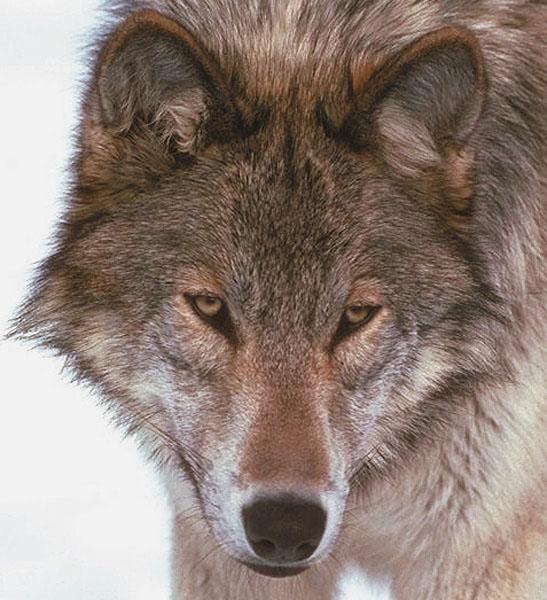| The Wolf What is the wolf? What is this magnificent creature that is so often portrayed as evil incarnate in the books and in the stories? What is this ancestor of the domestic dog? What is its nature? What is it like? |
 |
| The grey wolf, Canus lupus, is the largest member of the family Canidae. The color of the wolf varies depending upon the individual - in fact, some "grey" wolves are solid black or solid white with no grey on them at all. These wolves come in almost every grey, brown and tan hues that there are. In general, the fur of a grey wolf is mottled with many various shades and have darker patches on their backs with contrast to their more dominant coat color. Contrasting light and dark facial markings are also quite common, especially around the eyes to give the wolves a masked appearance. As with nearly all memmals, in wolves, there is such a thing as an albino wolf (with pink/red eyes) that is exceptionally rare. The area in which the wolves live in also seems to have influenced the color of the wolves, due, most likely, to natural selection. Up north, in the arctic, where the land tends to be covered in snow for most of the year, the wolves are mostly white. This is a major advantage for them because then they can blend more easily in and therefore keep the element of surprise with them when hunting. In forests, the more normal color of a wolf's coat is an effective camoflage. As a wolf moves or even rests, it blends into the background and can barely be seen. The coloration of wolves is not, however, useful in classifying grey wolves since it can vary so much between wolves that are very closely related. What color the coats of the parent wolves are has virtually nothing at all to do with the coloration of their litters - the pups will come in all hues of colors no matter what. The average weights for the grey wolf are between 100 and 125 lbs (45-57 kg), although the largest individuals recorded weighed 175 lbs (79 kg). A wide size range is seen among the various "races," or "subspecies," of grey wolves. Wolves have extremely dense underfur, which insulates them during cold winter, especially up in the Arctic. Over time, the wolves have spread out all over the continent and have branched out into geographical groups which have their own unique characteristics and natural histories. These are known as the "races," or "subspecies," of wolves. Intelligance and social behavior are two unique traits of wolves. They live and hunt in close-knit family groups, or packs. These packs have ranking structure, generally believe for keeping the pack organized for hunting and care of the pack. Wolf packs generally have the Alpha pair, the only pair that mates, a Beta, or supporter, subordinates, or other members of the pack, and the Omegs, who is usually a female that ends up bearing most of the pack's stress. Each of the wolves plays his or her own vital role in surviving. General knowlege about wolves tells us that male and female wolves dictate and control their own heirarchy. That is, the males maintain a separate pack order from the females and vice vera, although oftentimes all will enforce the position of the Omega wolf regardless of gender. Apparently, the Alpha wolves are not always the strongest wolves in the pack. It is thought by many to be a leadership role. That is, the one that is characterized by organisation and rallying skills, rather than sheer strength and domination. That is due to the nature of the pack, because the pack does not necessarily have to be as strong as possible. Rather, it needs to be as organized as possible, so that hunts can be successful in getting food into the bellies of all of the members. Usually, the Alpha, or Alphas, will be the first to eat at a kill and will get the best portion of the kill. Or course, this is not always the case - we cannot always know why wild animals do what they do. The Beta wolf is the member of the pack who does the "enforcing," so to speak. The wolf shows support for the Alpha and reminds other pack members who is in charge. Someimtes, this position is held by the Alpha's mate, instead of having her be the Alpha female. It all depends upon not only the pack and the behavior of the Beta wolf, but also how humans determine things. The Omega is perhaps the most vital role in a wolf pack. This wolf does bear the brunt of the pack's stress, but actually is comfortable with its position. I know, this sounds silly, but it's true. The Omegs also is not necessarily the weakest member of the pack. In fact, it is not unheard of for an Omega to rise straight from Omega to Alpha of a pack. Wolves reach sexual maturity around 22 months of age, and at this age, will typically leave their pack to find a new pack or mate. It often happens that a pair will meet, mate and form their own pack, joined by other loners they meet. An interesting fact about wolves that I read recently was that wolves seem to be immune to the effects of inbreeding. Incest. Yes, incest. While not usual, it does happen, as with the Isle Royale pack. Apparently, these wolves got to the island by using an ice bridge. When the bridge melted, they were isolated, so their only choice was to inbreed. Miraculously, they have survived. It has been more than 25 years and these wolves still survive, and, indeed, are as strong as ever. The wolves of the Isle Royale pack offer to researchers a unique oppurtunity. Wolves communicate with one another in several different ways. The most often used way is body lanuage, gestures and espression. Vocalising does occur in the form of howling and in other, more minor ways like whines, whimpers, yips and barks. When a pack is close together communcation is non-vocal. Howling occurs within a pack for reasons like rallying for a hunt, mourning, communicating with other packs and enforcing territory borders. Scent is also a form of cumminication among wolves. Wolves scent mark their territory and have been known to leave scent marks, or scat, as warnings or indicators to other packs. This particular behavior makes the wolves easier to track, as this is usually done on the more common paths used by wolves and other animals. Between the territories of two neighboring packs, there is usually comething referred to as No-Man's Land, or No-Wolf's Land, I suppose. This is an area that runs between the repective packs' territories that neither will enter. Is serves as a barrier keeping neighboring packs out and a safe place for lone wolves to travel. Lone wolves looking for a pack to "adopt" them might travel along these makeshift highways, vocalizing for an invitation into the pack. In joining a pack, wolves vocalize to invite the stranger inside the boundaries of the territory. The stranger and the rest of the pack will then sniff one another, where the stranger is checked out for diseases, or anything else that could endanger the pack. If the stranger is accepted into the pack, he or she will usually become one of the mid-ranking individuals, not usually the Omega, although that is entirely possible. If the stranger is not accepted into the pack, he or she will leave immediately to find another pack to accept them. Wolves depend upon hoofed animals for food. This is primarily elk, but does include deer, moose, bison, mountina goats, antelope, boar and other similar ungulates. It's actually documented somewhere that wolves tend not to hunt livestock, but rather prefer their wild prey, althought the taking of livestock by wolves does indded occur. The websites this information was taken from are listed in my links page, and I suggest that you visit them all. But first I have to create the page, so bear with me please. |
 |
 |